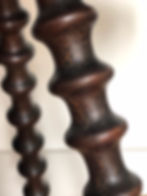A brief history of the art of bobbin turned furniture and the craft of woodworking
- Suzanne Branfoot
- Jan 29, 2024
- 2 min read
Updated: Jan 30, 2024

Antique bobbin-turned furniture has its roots in traditional woodworking techniques that date back several centuries. The term "bobbin turning" refers to the process of shaping wood using a lathe, a machine that rotates the wood while a cutting tool shapes it. This technique allows for the creation of cylindrical or tapering forms, resembling the shape of a bobbin, a small spindle or cylinder. The craft of bobbin turning was used to create various elements of wooden furniture such as table or chair legs, stretchers, and decorative details.
The popularity of bobbin turning in furniture making can be traced back to the 17th century, during the Jacobean and William and Mary periods in England. During the 17th century, England was experiencing significant economic and societal change. The rise of the middle class led to increased demand for furniture that was not only functional but also aesthetically pleasing. As a result, this period saw the emergence of new woodworking techniques, including the art of turning on a lathe.

The lathe allowed craftsmen to create intricate and repetitive shapes, such as the bobbins used in bobbin-turned furniture. This technique became particularly popular during the Jacobean and Elizabethan eras. The turned spindles and bobbins added a decorative touch to furniture, and the style became associated with a certain level of craftsmanship and quality. The use of turned wood spindles and legs became a distinctive feature in furniture design during this time. The turned elements were often applied to chairs, tables, and other pieces of furniture, adding a decorative and elegant touch.
During the 18th century, the Queen Anne and Georgian periods saw a continuation of the use of turned elements in furniture. Cabriole legs, a popular design feature during this time, often incorporated turned details at the top and bottom. Bobbin turning was also used in the creation of bedposts, chair legs, and supports for tables.
The popularity of bobbin-turned furniture continued into the 19th century, with variations and adaptations reflecting changing design trends. The Victorian era brought about a revival of various historical styles, including the incorporation of turned wood elements in furniture. The Arts and Crafts movement that emerged later in the century, led by figures like William Morris, sought a return to craftsmanship and traditional techniques, further influencing the use of bobbin turning in furniture design.
In the United States, particularly during the 18th and 19th centuries, bobbin-turned furniture was also popular. American furniture makers, influenced by European styles, incorporated turned elements into their designs. The Shaker community, known for its simple and functional furniture, also utilized bobbin turning in some of its creations.
The craftsmanship and attention to detail in antique bobbin-turned furniture make it highly sought after by collectors and enthusiasts today. Today, you can also find reproductions and modern interpretations of bobbin-turned furniture that pay homage to the craftsmanship and design principles of the past. The historical significance of this style of furniture continues to influence contemporary design, and bobbin-turned elements are often incorporated into pieces that blend traditional and modern aesthetics.
